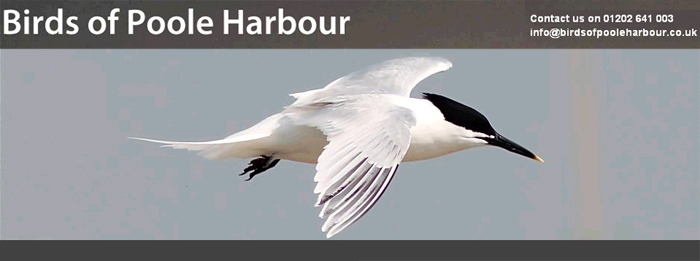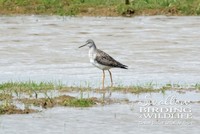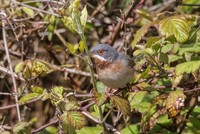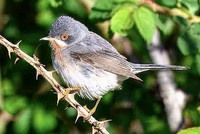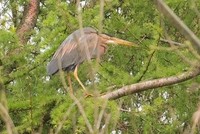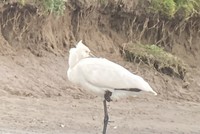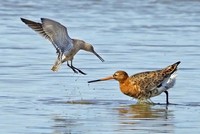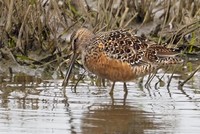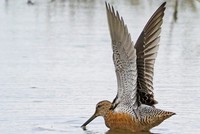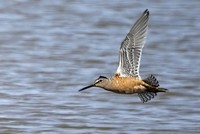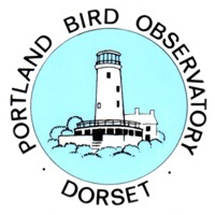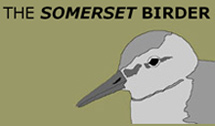Weekly round-up: 23 - 29 Apr 2014
Well, what a week. The weather became great. The birds become great. No, scrub that ~ the birds became amazingly great as the quality of species for 2014 went up and up and up.
I could waffle for an age about the pressure charts and weather systems that dropped feathered Manna from Heaven but most folk will have seen that all coming for themselves.
So without further ado. The megas.
It was all down to a bout of WTT (Warden Tag Team) birding on Fair Isle this week that saw this most famous of island’s score one of the most gob-smacking same-day doubles (even by Fair Isle’s extraordinarily high standards) in many a year.
Leading the way on a mind-blowing 27th was previous FIBO warden Deryk Shaw who unlocked the door to wonderment, shock and awe by discovering the earliest of our four “spring” Cretzschmar’s Bunting near his croft at Burkle. A handful of hours later he was to be followed by the current Head Honcho of all things Obs., David Parnaby, who popped in a delightful male Caspian Stonechat at the Meadow Burn, as a stunning birding day came to an almighty finale.

It had been coming too ~ students of weather patterns would have twigged sometime around Thursday that Shetland was looking ominously good for some off-the-scale head-turning weekend gems (my erstwhile Shetland colleague at the RBA review coal-face Jon Dunn predicting rare-bird carnage around the archipelago before Friday drew to a close).
Here’s a little more flesh on the bones…
Deryk had been watching a “new-in” Red-breasted Flycatcher near his croft towards the south end of the island when, emerging from the grass nearby came a stonking male Cretzschmar’s Bunting ~ cue consternation all round but the bird was up, off and away within just a few minutes, tho’ two stunningly gripping images were taken to capture this amazing find.
As Observatory staff began to scour the island in search of the departed mega, it was becoming readily apparent that birds were dropping like flies around the place ~ more on what else occurred later ~ but after a hefty few hours in the field, nothing was forthcoming by way of grey-headed Buntings. However, the consolation prize (what a consolation prize it was…) came in the form of an ultra-distinctive Stonechat that David found in the middle of the evening at Meadow Burn.

The strikingly pale underparts, coupled with an intense restricted blob of burnt orange on the breast, a monster collar and sizeable white rump hit all the right notes for a bird from the east before it dropped down off a fence to reveal the all-important, diagnostic Wheatear-esque tail pattern ~ the island had bagged its first-ever Caspian Stonechat.
BBRC Status: A
Accepted records: 4
2008 Sep 19 - 21 - Orkney, North Ronaldsay
1998 May 14 - 18 - Orkney, Stronsay
1979 Jun 9 - 10 - Shetland, Fair Isle
1967 Jun 10 - 20 - Shetland, Fair Isle
Fair Isle has now laid claim to three of Britain’s five Cretzschmar’s Bunting ~ the first (and Britain’s first too) was found on the island in June 1967, spending 11 days there from 10th. The second for Fair Isle and the second for Britain reached the island in June 1979 ~ a two bird appearing on 9th (and made famous by an appearance in the pages of Bill Oddie’s “Little Black Bird Book”).
After a gap of 12 years (almost to the day) between birds one and two there followed a 19 year hiatus until the next one appeared ~ Orkney chalking up their first Cretzschmar’s record when a male was found on the cliffs of Stronsay on May 14th 1998, a bird that lingered (albeit uber-elusive and erratic) for four days. The autumn duck was broken 10 years later with Orkney’s second, the heavily twitched bird found on North Ronaldsay in 2008 giving eager beavers everywhere a three day chance for listing glory.
Now Deryk Shaw’s bird of April 2014 has pushed Fair Isle (and Shetland) back in to top spot with the third record for the island (and islands) and has brought the spring window of opportunity into an ever-increasing, widening gap ~ late April to mid-June now the target date for future finders…
Caspian Stonechat is a (sub)species that has been on the radar for a couple of weeks with a single bird appearing to have ventured through Scandinavia (in Sweden and Norway, tracking west from one country to another and being last seen on April 19th, putting it bang on track for Shetland) , so perhaps this week’s British individual wasn’t quite the surprise that the Bunting was.
From the photos posted by David Parnaby on the always excellent Fair Isle Warden’s blog, it looked as though, despite the favourable trajectory of the Scandinavian bird, the Fair Isle male was a different beast.

Whether it was less of a surprise or not, nothing should detract from such a stunning follow-up find ~ and the form variegatus or hemprichii isn’t now the mystery it once was, even in comparatively recent terms, thanks to the spring male at Pool of Virkie during the first week of May 2006 and, of course, the first-winter male that popped up on St. Agnes (Scilly) at the tail end of last autumn. These two had followed an autumn male in Suffolk in September 1993 and Britain’s first, the bobby-dazzler at Porthgwarra in October 1985.

The worrying thing for rarity hunters, as Sunday drew to a close, was that Shetland had a couple of days of tasty weather to come before those chilly northerlies were due to kick in….

…as it turns out, the rarity hunters on Fair Isle actually managed the impressive feat of re-finding firstly the Stonechat after a morning long search and, almost 24 hours after the brief hello-there at Burkle, the Bunting at Gillie Burn. The odd plane was scrambled and the chase was on…and both the Cretzschmar’s and the Caspian did the business on 29th too.
Two weeks ago, this review gave fair warning that we were long overdue an Alpine Accentor ~ the species popping up on these hallowed “pages” by virtue of a “heads up” to the fact that we were rapidly approaching the 10th anniversary of our last British record.
Last week, this review brought news of an Alpine Accentor on the near-continent, found in Belgium on April 20th (the very same date that carried with it the somewhat ambitious prediction of a potential return to our shores 10 years to the day since that last Norfolk record of this characterful, colourful sub-montane creature).
This week, this review is delighted to report that the hoodoo has been broken, Alpine Accentor has fallen once again and spring duly upped her game a little more in the process too.

Found during the early morning near the Bird Observatory at Holme NOA in Norfolk on the morning of 26th, this single observer bird was captured for perfect posterity by long-time local patch worker Connor Rand ~ and here’s a little more from the lucky man himself…
”A quick peek at the charts and conditions on Thursday evening, after I’d finally handed in my dissertation, suggested that Saturday could be prove to be a good spring day, with rain on the Friday and overnight and the easterly winds swinging round towards the south, with the low pressure system extending onto the continent. Myself and NOA warden Sophie Barker were on site around the Holme NOA reserve at about 06.45hrs.
It was bright and clear early on, with quite a lot of movement including a single Ring Ouzel. On reaching the Observatory building, carrying rather too much, I put up a bird up off the benches which flew into the pines. I'd only seen it with the naked eye in flight, but it felt different. Over half an hour of searching later and I was getting more and more frustrated when a bird dropped out from the pines next to me and onto the handrail.
Incredibly, it was an Alpine Accentor! The bold rufous-brown streaks on the flanks were instantly obvious, as was the yellow base to the bill, the grey ‘hooded' appearance and the dark panel across the wing. Being all alone I decided it was best to take a few pictures! And I’m rather glad I did. It flew back up into the pines after about a minute, at which point I ran, screaming and crying, along the east bank to tell Sophie.
A search revealed nothing and after closing nets it was time to put the news out. A long search ensued, with many local observers and some from further afield, but remarkably there was no sign by dusk. Thankfully, the photos were good enough and showed all the key features I'd seen in the field! I would dearly have loved to share this bird with everyone, especially the Holme regulars, but clearly it wasn’t meant to be.
Let's just hope the next one sticks...“
Texts and calls made the previous day by the few active bird-finders along the Norfolk coast all gave lie to the suspicion that the gloomy, cool, murky and wet easterlies were about to drop something huge in the area and these gut-feelings were proved right thanks to Connor’s super discovery, though sadly for those who gathered subsequently and, as mentioned above, there was no more sign of this in-and-out mega.

This becomes the sixth April Alpine Accentor from a grand total of (now) 35 birds ~Sussex claiming the first of those half dozen records (at Seaford Head from April 7th-20th 1921 and Telscombe Cliffs on April 24th 1955) followed by the much-twitched (at the time) bird at Portland between April 8th-30th 1978 with a Norfolk bird following at the end of the same month, from April 30th-May 4th 1978.
The final record of an A.A.A. (April Alpine Accentor) came ~ as detailed here two weeks ago ~ on the undercliff at Overstrand on April 20th 2004. And that was it…until Connor’s well deserved find ~ a find that also finally awoke the behemoth that is Norfolk from its rare-bird slumbers, being the first genuine Mega in the county since the wintering Western Sandpiper of 2011-’12.

Only May has seen more Alpine Accentor records, eight noted in that magical month, with March, October and November all logging three each.
Alpine Accentor is a bit of a curio for the new generation of listers who’ve taken up the game post-2004 ~ many twitchers before them have managed four birds, many starting with the bird on the Isle of Wight in the incredible spring of 1990, followed by the four-day adult in Lincolnshire in November 1994, with another four-day stayer at Minsmere in March 2002 also helping things along.
Add in the 2004 Norfolk bird and hey presto! A whole heap of them! Go back another generation and make it five ~ plenty of active listers now saw that Portland bird in ’78. Now the 10 year blank is broken, so maybe there’s an available one just around the corner…
After the weekend’s stunning showing of three outstanding birds, the prospect of more outstanding arrivals diminished, mainly by virtue that most birders were back at work. However, conditions were (on paper) still pretty decent along almost the whole of the east coast, and the further north you went the better it looked.

Then as the evening of 28th loomed large, a male Collared Flycatcher was found at St. Abb’s Head (Borders) at the south end of Mire Loch, becoming the first county record in to the bargain. And what a beauty he was too!

Up until the end of 2011 there had been 36 accepted records of this fabulous Ficedula and have been followed by the grey first-winter male on Tory Island in Donegal in May 2012 and males in Northumberland, Shetland and East Yorkshire in May last year with another male photographed in Highland in June with the fifth of 2013, a female, making landfall on Fair Isle, also in June.
Despite just over 40 records now, this remains a desperately rare bird in April ~ this week’s is only the fourth to date and the second to be discovered on April 28th (the other was the popular male at Portland in 2009) while the other two have been found on different April 30th (in 1999 in Aberdeenshire and Fair Isle on 2011). This week’s dazzling drake remained to 29th.

Spring 2014 landed a third Great Spotted Cuckoo this week, seen and photographed along the track to Kynance Cove, on the Lizard (Cornwall) on 24th to follow on from the previous records at Giltar Point in Pembrokeshire from March 11th-23rd and at Branscombe (Devon) on April 4th.
Cornwall has now registered nine records of the species, the most recent coming in 2009 when one (presumably just one…) was noted around Crows-an-Wra on March 22nd and the April 1st-6th 2009. Prior to that was a bird on Land’s End in March 2001 and then comes a gap all the way back to 1982 when a first-summer was found near Wadebridge on April 7th of that year. Five of those nine Cornish records have now been in April while the British and Irish tally (from c.59 records overall) is now of 17 for the month as a whole.
Last week saw the surprise appearance of Devon’s first Collared Pratincole in quite a few decades (nigh on six of ‘em) but the cheeky chappie didn’t really feel like playing the game ~ in the two days present at Northam Burrows on the north coast of the county (on 21st and 22nd), it showed only intermittently and generally distantly too.

Fast forward to this week and on the afternoon of 26th, as the Nouveuax Listers had wrung out there hankies after the realisation that the Acc-Attack was over, up popped the Pratincole, back on the mud and then the golf course at Northam and stuck around long enough through the afternoon and evening to give plenty of Devon birders another bite at the Collared cherry. And by staying on to 29th it gave everyone a fair crack of the whip.


Another bird that dropped out of the news for several days (just shy of a week actually) was the drake Baikal Teal on the Ouse Washes, near Pymoor (Cambridgeshire).
Present on 21st, there was no news at all after the Easter Hols until we landed on the weekend and at 26th ~ the boyo still in situ and edging closer to the bin marked “plastic fantastic”. It still has a way to go but who’d wanna tick it if it was still there in mid-May or later…?
After a tentative late nibble at the tail-end of last weekend for a Pied-billed Grebe on Loch Thom (Clyde) ~ listed only as a probable at the time and with no follow-up news ~ the bird was reported again initially as a possible on 24th before finally coming together later the same day.

With no sign on 25th, it seemed as though the trail in Clyde had gone cold but up it popped again on 26th and promptly showed well to all comers to the end of the week. A first for the county, Pied-billed Grebe remains a rare bird on the Scottish mainland ~ this is now the seventh ~ and the first since an adult was filmed in Highland’s Harrow Harbour in May 2002.
It has been a good year so far for Pied-billed Grebe ~ along with the ever-present wintering bird on the Outer Hebrides, we’ve had the twitchable bird in Leicestershire (at Rutland Water earlier this month), last week’s reappearance of the bird on Mayo’s Achill Island and now the Loch Thom individual too. Four in a year puts 2014 on a par with 2010 and 2000, but lagging behind the six of 1997, 1998 and 1999.

Over on Dursey Island in County Cork, Ireland’s third-ever Sardinian Warbler remained in Scott’s Garden until 25th ~ a five-day stay that puts it second in the list of Ireland and Cork’s trio to date. Those two April birds in 1993 stayed for eight days on Knockadoon Head and for three days on Cape Clear Island.
Two White-billed Divers continued to hang out in the North Sea, off Portsoy (Aberdeenshire) to 28th with one still in the area to 29th. One was noted off Kettla Ness, West Burra (Shetland) on 27th but other records were understandably thin on the ground given the advancement of May…
Skua action picked up a tad ~ but only where Poms were concerned. It was almost a South Coast clean sweep too ~ bar lone birds off Bowness-on-Solway (Cumbria) on 26th and Baltimore (Co. Cork) on 29th all other records this week were spread between Devon to Kent.
We’re still not in to big flock time so the tally of some 30 birds in all was certainly on the modest side, and Splash Point, near Seaford (East Sussex) collecting half a dozen birds before the weekend with Dungeness (Kent) and St. Catherine’s Point (Isle of Wight) also logging birds on more than one date this week. The week closed with two from Splash Point and one off Dungeness on 29th.
An unseasonal Little Auk was reported as showing well at the Lizard’s Church Cove on 25th and there were two Balearic Shearwaters were recorded from Thurlestone (Devon) on 26th.
The stunning adult Night Heron that arrived recently on the Shetland Mainland continued to show well in the area around Loch Spiggie until 26th at least. New was another adult, found on the Wirral at Leasowe on 23rd where it showed (very infrequently) through to the 26th ~ the first record in the area since one was reported along the River Dee in June 2005.

Scotland kept hold of both of the country’s two single Glossy Ibis this week, still present at Vane Farm RSPB, Loch Leven (Perth & Kinross) and on North Ronaldsay (Orkney) to 29th. In the east Midlands, the long-staying singleton at Lowdham (Nottinghamshire) was present to 24th as well while in the northwest of the Midlands, on the Warwickshire/Staffordshire border, a Glossy Ibis remained in the Middleton Lakes area until 29th.
In East Anglia, three birds were recorded again ~ one was back at Hickling Broad NWT (Norfolk) on 24th-26th while the pair at Pymoor, on the Ouse Washes (Cambridgeshire) remained to 26th at least. Another Glossy Ibis duo were seen in West Sussex on 23rd-24th, at Lidsey while in the southwest of England singles were seen at Ruan Minor (Cornwall) and Weston sewage works (Somerset) on 26th. The final birds (in a tally of 16 in all) were seen at the National Wetlands Centre WWT (Carmarthenshire) from 24th-28th, Erewash Meadows NR (Derbyshire) on 28th-29th with two evening singles over the Lune Estuary (Lancashire) on 29th.

Two of the week’s three (or perhaps four) lone Cattle Egrets were birds that had been present over recent weeks ~ seen to 24th at both Steeple Claydon (Buckinghamshire) and on the Ouse Washes RSPB (Cambridgeshire). The latter county saw another Cattle Egret reported from fields near St. Neots on 25th and in Ireland, following a single at Tramore Backstrand (Co. Waterford), two were found at Tacumshin (Co. Wexford), all three found on 27th, with the “Tac Two” still present to 29th.

Great White Egrets were spread far and wide again this week ~ the northeast saw singles noted at Gibraltar Point NNR (Lincolnshire) on 23rd and at Cresswell Ponds NWT (Northumberland) on 25th relocating to Druridge Bay the next day. In Cheshire, a single was noted at Burton Marsh RSPB on 28th while two were again logged on the Ouse Washes on 24th. Further south again there was one each for Littlehampton (West Sussex) on 23rd, London’s Brent Reservoir on 26th and Dorset’s Frome Valley on 28th.

Two Great Whites were at Shapwick Heath NNR during the week and another Great White duo appeared on Tinker’s Marsh, Walberswick (Suffolk) on 29th while the week’s largest group reported was of four at Crossen’s Marsh (Lancashire) on 23rd with another reported at Leighton Moss RSPB ~ also Lancashire ~ the following day.


Four Spoonbills remained in Poole Harbour (Dorset) at the start of the week, while further multiples included two on the Ouse Washes, also on 23rd before the Dorset group rose to nine (present at Middlebere Farm) on 28th. Singles through the week were recorded in eight different coastal counties, from Northumberland through East Yorkshire, Lincolnshire, Norfolk and Suffolk to Kent, East Sussex, Hampshire, Gwent and Carmarthenshire, with an Irish Spooner found at Reagh Island (Co. Antrim) on 28th.
Along with the two Glossy Ibis at Lidsey in West Sussex there were also two Common Cranes on 23rd and they were followed by a single in Highland, at Lochluicart, two over Tophill Low NR (East Yorkshire) and four at St. Fagans (Glamorgan) on the same day. Seven Broadland birds were at Winterton on 24th and as two circled over Attenborugh Pits (Nottinghamshire), another was seen drifting over Grenitote, North Uist (Outer Hebrides) with one at Lynton (Devon) all on 24th.
The Hebridean Crane popped up on South Uist on 25th (at Askernish) when seven birds flew over Galton Heath (Dorset). Back in Norfolk, two were again at Strumpshaw Fen RSPB on 27th and two more were tracked across Hertfordshire at Amwell NR and then Rye Meads RSPB on the same date. In East Sussex, a single bird spent a couple of days at The Brooks on 27th-28th (heading over Arundel on 29th) and a single was found at Quendale on the Shetland Mainland on 28th. The week concluded with two Cranes over Abingdon (Oxfordshire) continuing to Coombe Hill Meadows (Gloucestershire) on 29th.
After an unsubstantiated report or two of Black Stork this spring, the first confirmed record came on 28th when one was seen heading across Whixall Moss (Shropshire) ~ if accepted it will be the second for the county, following on from one in the Upper Terne Valley in August 1990.
A White Stork was seen well in Berkshire, at Spencers Wood during the morning of 24th before heading off over nearby Burnthouse Lane GPs before noon. The 26th saw single birds head over Fen Drayton and Swaffham Prior Fen (Cambridgeshire) and also Kennington (Oxfordshire) while the bird noted in east Norfolk, near Halvergate on 27th was of dubious origins (the free-flying unringed birds of Thrigby being the inevitable fly-in-the-ointment). The same goes for the two birds reported at Buckenham Marshes RSPB on 28th (in the same general area that two Cranes have been seen).

Single Spotted Crakes stayed put on Lower Moors, St. Mary’s (Scilly) to 23rd and lone singing males were recorded again at Ouse Washes RSPB (Cambridgeshire) on 23rd and Grove Ferry NNR (Kent) to 26th, with a new bird at the Kennington Preservation Field (Oxfordshire) on 27th-29th.
An adult Gray-bellied or Lawrence’s Brant was noted again on the beach at Dundrum (Co. Down) on 23rd (one was seen at the same site on April 9th and is presumably the same bird). A Black Brant was noted on the saltings at Stiffkey (Norfolk) on 24th and one was again at Levington Creek (Suffolk) on 28th.
Two white Snow Geese were seen at Muck (Highland) on 23rd and a intermediate-blue bird was found on Tiree, at Cornaigmore the following day and it remained on the island to 28th.
The female Blue-winged Teal found last week at Sandwich Bay (Kent) remained on site to 29th and a female Lesser Scaup spent two days in an area with no general access in Nottinghamshire on 23rd-24th while in Staffordshire, the male Lesser Scaup was back at Tittesworth Reservoir on 25th-26th at least (he was last noted here March 27th ~ could it be a different bird passing through?)

The drake Ring-necked Duck lingered on the Nene Washes (Cambridgeshire) to 26th and between 27th-29th a drake was seen at three sites in Shropshire (Wood Lane NR and then Ellesmere and White Mere) while in Derry, two birds were still on Lough Beg to 27th (along with a Green-winged Teal). Another Irish bird, a drake was on the border of Roscommon and Sligo on 28th, seen on Lough Skean.
That Derry bird mentioned a moment ago was one of five drake Green-winged Teals logged this week ~ the week began with one still at Stocks Reservoir (Lancashire) on 23rd and was followed a new arrival at Alkborough Flats NR (Lincolnshire) on 24th, Loch of Spiggie, Mainland (Shetland) on 25th and Tory Island (Co.Donegal) on 26th.
On the pretty Ythan Estuary in Aberdeenshire, a drake King Eider was back on station for another summer from 25th with presumably the same drake noted off nearby Blackdo0g the following day. A queen remained off the Fife coast too ~ still at Ruddon’s Point until 27th. Just two Surf Scoters were recorded through the past seven days ~ off Rerwick Head, Mainland (Orkney) on 28th and still at the mouth of the River Esk, at Musselburgh (Lothian) throughout the week.
A couple of weeks ago, the arrival of a flock of 10 Black-winged Stilts on the Isle of Wight was worthy of headline news ~ this week, despite the same incredible number making landfall briefly at Dungeness on 24th they were rather overshadowed by the happenings in Shetland and Norfolk.
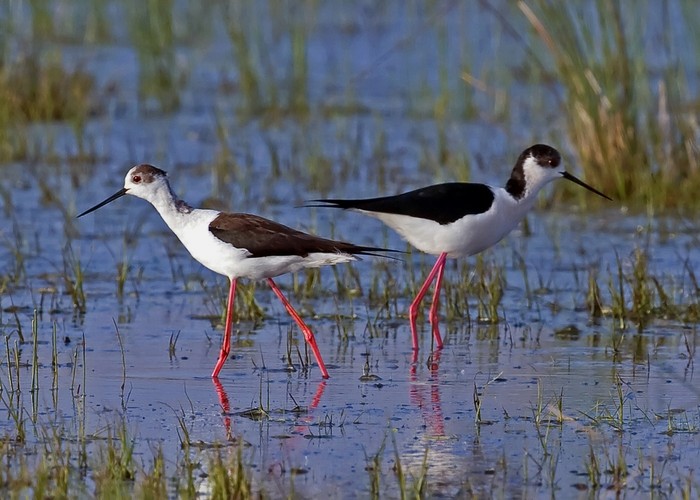
The double figure group appeared on the Hayfield area of the RSPB reserve at midday before heading off but two birds appeared a couple of days later and remained there to 28th at least. As mentioned here recently, 10 is a record-equalling group, prior to 2014, there had been just one double figure flock in Britain ~ at Bovisands, in Devon, in May 1945.

The week concluded with a single Black-winged Stilt at Bracklesham Bay RSPB (West Sussex) on 29th ~ the same site hosted the county’s most recent record of the species, present for a day in June 2012.
In East Yorkshire, a brief Marsh Sandpiper was seen on a private farm pond at Burton Pidsea, near Hedon on 29th ~ the seventh for Yorkshire overall and the fourth in East Yorkshire, the most recent being one at Blacktoft Sands RSPB in July 2011.
A Kentish Plover spent the day of 26th at Rye Harbour NR (East Sussex) and was followed by a Temminck’s Stint there the following day. That was the second of the week, following on from one the previous day at Oare Marshes NR (Kent) while a third appeared in Suffolk, at Hollesey Bay on 29th.
Just over 30 Dotterels were found this week ~ on 23rd, three were still on St. Martin’s (Scilly) while two were located in North Yorkshire, at Blubberhouses, with the same county scoring three more the following day at Ingleborough (with five present on 25th). Also on 24th came eight birds at Tetney and Northcoates (Lincolnshire) while 25th saw three birds arrive at Black Bush (Cambridgeshire) (where they stayed to 27th).

On 26th, the favoured fields of Choseley (Norfolk) hosted a trip of four (with the same group there again on 29th) and a lone Dotterel was noted over Stone Creek (East Yorkshire). Two birds were found in Cleveland, at North Gare on 27th and singletons were at Filey (North Yorkshire) and Grainthorpe (Lincolnshire) on 28th and Pendle Hill (Lancashire) on 29th. The final birds of the week were the two seen in Dumfries & Galloway, on Lowther Hill, also on 29th.
Across on Islay, the first-summer Thayer’s 'type' Gull was again at Bruichladdich, along the shores of Loch Indaal until 25th at least.


After a second-winter Franklin’s Gull was reported in Wales last week (in Glamorgan, at Wernffrwd) this week saw Carmarthenshire record just the second record of this long-haul traveller (the first came in the November 2005) when a first-winter was found at the National Wetlands Centre WWT on 23rd ~ where it came and went until 28th. On the evening of 27th it was (back?) in Glamorgan heading north over the river border crossing between the two counties at Pen-clawdd.

The only Ring-billed Gull this week was a first-summer on the Shetland Mainland, at Quendale on 24th while Kumlien’s Gulls remained stuck on two youngsters ~ the Fair Isle bird present to 27th and the Littlehampton bird present to 29th.
At least 48 Iceland Gulls continued to hold on through the last full week of April, with two for Wales, nine for Ireland (three each in Cork and Donegal), 11 across England and 26 for Scotland. Of those 14 were recorded on islands, with up to eight around the Outer Hebrides the largest number from the past few days. Shetland registered three and Orkney four.
Half the number of Glaucous Gulls were seen this week, just 21 reported with Scotland and England nudging ahead of Ireland with seven each to the Irish six. Wales collected one. Three of Ireland’s half dozen were noted on the Mullet (Co. Mayo) on 27th with two behind the Inishbofin ferry (Co. Galway) on the same day.
Right on cue this week, another decent prediction in the shape of Whiskered Tern ~ up to three singles found through the last seven days.

The first appeared at Rockland Broad (Norfolk) on 24th ~ the third site record, following on from two there in May 1994 and a single in May 1999. Norfolk has now clocked up 24 records of this super marsh tern but this is the first record since an adult spent an afternoon and evening over the Freshmarsh at Holkham in late April 2008.

Bird number two spent a little time at Otmoor RSPB (Oxfordshire) on 25th (what odds that it was one-in-the-same as Norfolk’s bird?) ~ and becomes only the second county record (the first was a five day bird way back in 1970, when it was mainly in Berkshire...) while the third record for the week was seen flying through Minsmere RSPB (Suffolk) on 26th ~ the sixth for the county and the first since one at Lakenheath Fen in May 2005.
The Black Kite reported from the Orkney Mainland at the end of last week was still in the Birsay area on 23rd, with the same day seeing one noted on Mull (Argyll & Bute) and there were followed birds over Grafham Water (Cambridgeshire) on 26th and the A12 at Wangford (Suffolk) on 29th.
The first passage Montagu’s Harriers of the year were found this week. First was a lingering female on the Lizard, at Croft Pascoe from 23rd-27th and further records included a report of a male from Leighton Moss RSPB (Lancashire) on 26th with singles in East Yorkshire the same day at Blacktoft Sands RSPB (a male there) and Goole Ferry (a first-summer female). A ringtail was seen over Welwyn Garden City (Hertfordshire) on 27th and 28th saw another ringtail noted at Gibraltar Point NNR (Lincolnshire).
Also new this week was a Honey Buzzard, seen heading over Exminster Marshes RSPB (Devon) on 28th with another following the day after at Choseley (Norfolk).
It is pretty tricky to know just where to start things off here in Passerine Corner but perhaps given Shetland’s dominance in the Top Drawer carry-on let’s taking in the two superb male Eastern Subalpine Warblers found around the islands this week should be our starting point.
The first was found in gardens around the edge of the Pool of Virkie at the southern end of Mainland on 24th, where it remained to 27th at least. The second Shetland bird of the past seven days was the mere warm-up act for what was to follow on Fair Isle, one trapped in the Observatory garden on 25th, that bird too staying to 27th. The third bird of the week, a male Subalpine Warbler sp. was found in Borders, at Mire Loch on 28th ~ the second for the site (the first appearing there in 1997) and only the fourth for Borders as a whole (and a nice addition to the day’s avifauna there, along with the Collared Fly…).


There’ll be plenty more Shetland birds to come, but up next are a trio of pleasing spring Little Buntings. After all the commotion-near-the-ocean at Holme on 26th, birders around the NWT side of the split site located a short-staying pusilla on 27th (it was in and out within five minutes) and it was followed by a bird on the west coast, trapped and ringed on Hilbre Island (Cheshire) on 28th. Almost inevitably, the third was on Fair Isle on 29th ~ an awesome double-header of a bunting-fest.
On Bryher, the first Red-throated Pipit of the year was found in fields near Popplestone Bay on 25th and a new Tawny Pipit spent 24th on the golf course at Scarborough (North Yorkshire). New Richard’s Pipits were found at Brand’s Bay (Dorset) on 24th, Girdle Ness (Aberdeenshire) on 26th, flying west along Blakeney Point (Norfolk) on 27th, in Filey’s Top Fields (North Yorkshire) on 28th and at St. Abbs Head (Borders) on 29th. The wintering, very elusive north Norfolk coast bird at Gramborough Hill, Salthouse was seen on 23rd and again on 29th.


As mentioned earlier, a Fair Isle Red-breasted Flycatcher lead to the discovery of the Cretzschmar’s Bunting on 27th and that was one of two seen on the same day ~ the second, an adult male, was at Hook Head (Co. Wexford). Another RBF was reported from the Dump Clump, on St. Mary’s (Scilly) on 28th and one was found at Whitburn (Co. Durham) on 29th.


That amazing day on Fair Isle also saw three Short-toed Larks found around the island (a remarkable total in itself) while the tally of seven spring Wrynecks harks back to the 50’s.

Those seven birds on Fair Isle on 27th were part of a remarkable arrival of at least 42 (bare minimum) through the week. Day tallies on Fair Isle itself meandered up and down daily 1, 4, 1, 3 then the 7 on 27th, while a further 16 or more were seen elsewhere on Shetland to the end of the review period, including three at Hoswick on 25th. Five Wrynecks were found along the Norfolk coast with four in Northumberland, while there were two for Orkney and Suffolk, with several singles dotted along the east coast for good measure.



New this week was a singing first-summer male Woodchat Shrike in Wales, at Gileston (Glamorgan) on 28th-29th. Slightly earlier than usual were the three male Red-backed Shrikes reported through the week ~ the first was reported at Gibraltar Point NNR (Lincolnshire) on 23rd with further singles coming along to Barns Ness (Lothian) and Rerwick, Mainland (Shetland) on 27th, while a female Red-backed Shrike was found at Torness (Lothian) on 28th in a productive day for the east coast of Scotland.

After a blank seven days, a further tiny pulse of vagrant Great Grey Shrikes came our way, after single bird days on 23rd and 24th, Fair Isle made it two on 25th when another was found at Penicuik (Lothian).
The reasonably strong showing of April Red-rumped Swallows was topped up a little more as the month drifted to a close ~ four birds listed with singles at Steyning (West Sussex) and St. Mary’s (Scilly) on 27th and 28th, while one became two at Marazion Marsh RSPB (Cornwall) over the same two dates. The 29th saw a couple more Scilly Red-rumped Swallows noted, again on St. Mary’s and also on St. Agnes. Across on St. Martin’s, a Golden Oriole appeared on 28th when another was a brief visitor to Goonhilly Downs on the Cornish mainland.

Hoopoes nudged into double figures for another week, with at least 16 noted, spread from the tip of Cornwall to the northeast of Scotland. On 23rd, half a dozen birds were reported, with lingering birds at Stranraer (Dumfries & Galloway), Lands End (Cornwall) and Ballywilliam (Co. Cork) while new ones were found at Gibraltar Point NNR (Lincolnshire), Inverscaddle Bay (Highland) and Reenroe (Co. Kerry).

The 24th found newly arrived Hoopoes alighting on Pembrokeshire’s Ramsey Island and Dorset’s Studland Heath and on 26th the east coast scored with singles at Kessingland (Suffolk) and Torness Point (Lothian) while one arrived on St. Martin’s (Scilly). Aberdeenshire saw a Hoopoe reported from Stonehaven on 27th with one in North Yorkshire, at Ampleforth the same day and Portland welcomed another on 28th. The final ones of the week were seen on the Gower Peninsula, at Langland Bay and also in gardens in Pollokshields, Glasgow on 29th.

Hoopoe video gallery
Leswalt, Dumfries and Galloway (© Colin Bushell Leswalt, Portland Bill, Portland (© Martin Cade Portland Bird Observatory
Leswalt, Greenlands's Farm, Studland, Dorset (© Birds of Poole Harbour Leswalt, Carrig on Bannow (© Marc Mc Loughlin
After a decent mix of Serin records last week, things settled down to a more normal batch across the past few day. The first was noted heading west over Stanpit (Dorset) on 23rd and the female on South Uist (Outer Hebrides) was seen again on the same day. The last one popped up in West Sussex on 28th, sen at Church Norton.
It looks as though the Hume’s Yellow-browed Warbler has finally done a bunk from Dungeness but there were four new Yellow-browed Warblers on offer, including one at...Dungeness! First was one at Torness (Lothian) from 25th-28th and was followed by one at Wester Quarff, Mainland (Shetland) on 26th when one was also reported at Sands of Forvie NNR (Aberdeenshire) while the Dunge inornatus was seen on 29th.


With May coursing ever-closer, there was little surprise that numbers of Two-barred Crossbills had dropped to just a handful as the fifth month of the month approaches.
A first-winter male Two-barred Crossbill was at Lynford Arboretum (Norfolk) on 23rd and two males were still present there on 28th. The 23rd also saw a male noted as still present at Broomhead Reservoir (South Yorkshire) and on 25th, another lone male was seen in the Wyre Forest (Shropshire). Back in the Brecks, on the Suffolk-Norfolk border, a male Two-barred Crossbill appeared at Santon Downham on 29th.

Cool conditions appear to be on the way for many of us as the weekend approaches (certainly down the east side of the country) as a generally northerly airflow kicks in for a few days (tho’ it won’t be a full-on blast of chilliness, more a gentle waft) and it may get a little warmer after that...
With May within our grasp we’d normally be thinking that the best birds of spring will be with us any day, but this week has already offered up three contenders for “Bird of the Spring” already. If (and it’s a big “if” at the mo) the weather gives us a helping hand we could see a Broad-billed Sandpiper making it across the Channel or North Sea ~ we’re coming in to a great time of year for these supreme little shorebirds ~ and those first Red-footed Falcons and Citrine Wagtails could edge our way.
The week ahead is a wonderful period to try and find a Red-rumped Swallow, five out of seven days between April 30th and May 6th have hit double figures with 16 accepted for April 30th, 15 on May 2nd, 14 on May 3rd, 15 on May 4th and 11 on May 6th.
After mentioning Caspian Plover over the past couple of weeks, it would be remiss not to point out that Fair Isle scored a female of the species on May 1st 2008 and we are still due one in the UK this spring….
A sticking, showing Lesser Short-toed Lark would go down a storm too ~ our only one (still discussed in hushed tones in some quarters) appearing on May 2nd 1992 at Portland. And while we’re on the subject of long overdue megas, our last Yellow-browed Bunting (and only spring one) was found on Orkney on May 4th 1998 ~ the third one in the 90’s and only the fifth-ever but there’s not been a single whiff of one in the past 16 years.
But let’s look at May 5th for the Real McCoy. This is a date that has produced some great birds but none better than the first Audouin’s Gull found at Dungeness (five more have followed) and the three Slender-billed Gulls that also appeared on the same date ~ at Kent’s Grove Ferry in 1999 and Cley’s second peachy pair exactly one year later (with the last one recorded here coming later in the same month in 2000, at Dungeness). Fourteen years an counting on that one as well then…maybe that’s the species for next week?
So, ultra-gulls, uber-waders, unfeasible larks and buntings are all on the agenda. And the chance of something crinkling good carrying the Stars’n’Stripes is also something that shouldn’t be forgotten about either. You’ve gotta love May right!
I’m off to run my Red Flag up the ‘pole on the 1st of the month and Jon Dunn is in the chair next week. Will any of the above feature in the headline news? Tune in to find out more comrade brothers and sisters.
Mark Golley
30 April 2014
Special thanks this week to Deryk Shaw, David Parnaby and the Fair Isle Bird Observatory for their images of the Cretzschmar’s Bunting and Caspian Stonechat. Special thanks also to Connor Rand for the photos and account of his Norfolk Alpine Accentor.
Thanks also to the rest of this week's contributors for their photos and videos...






